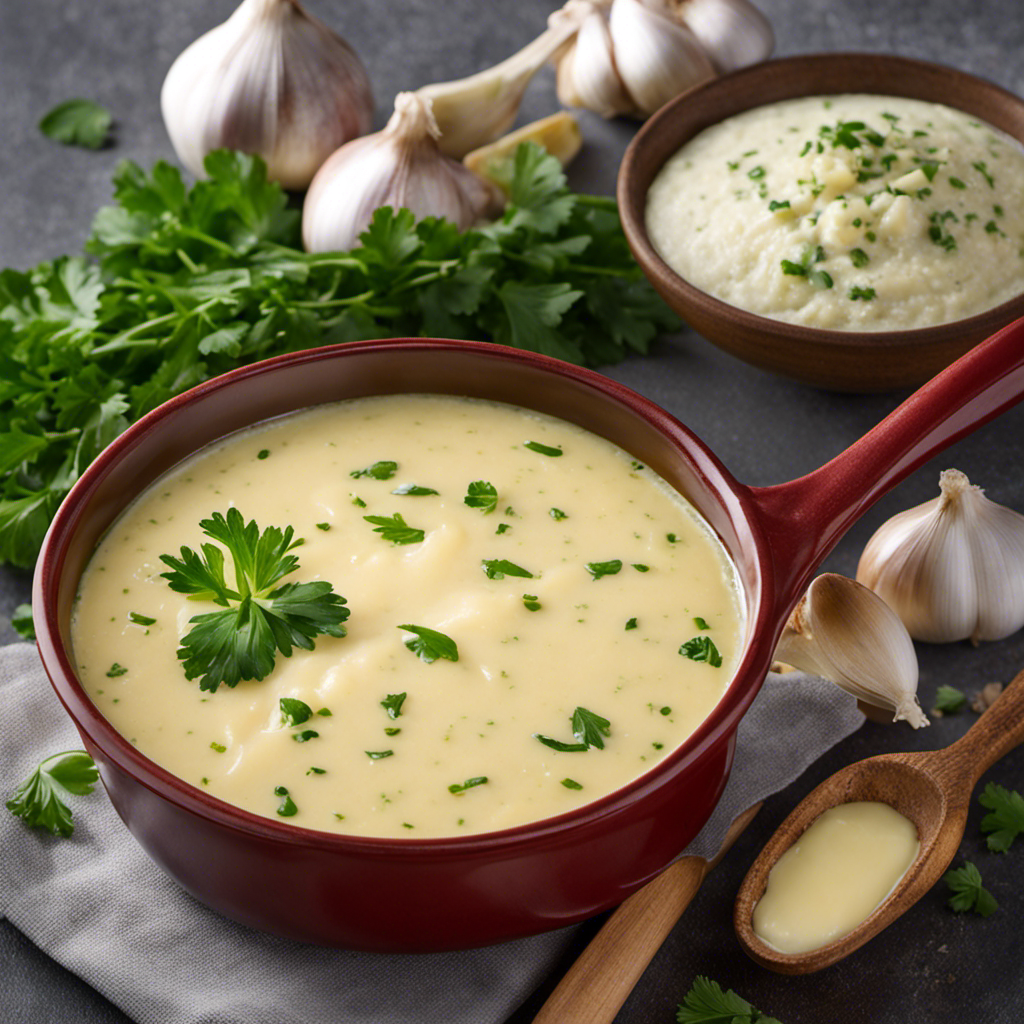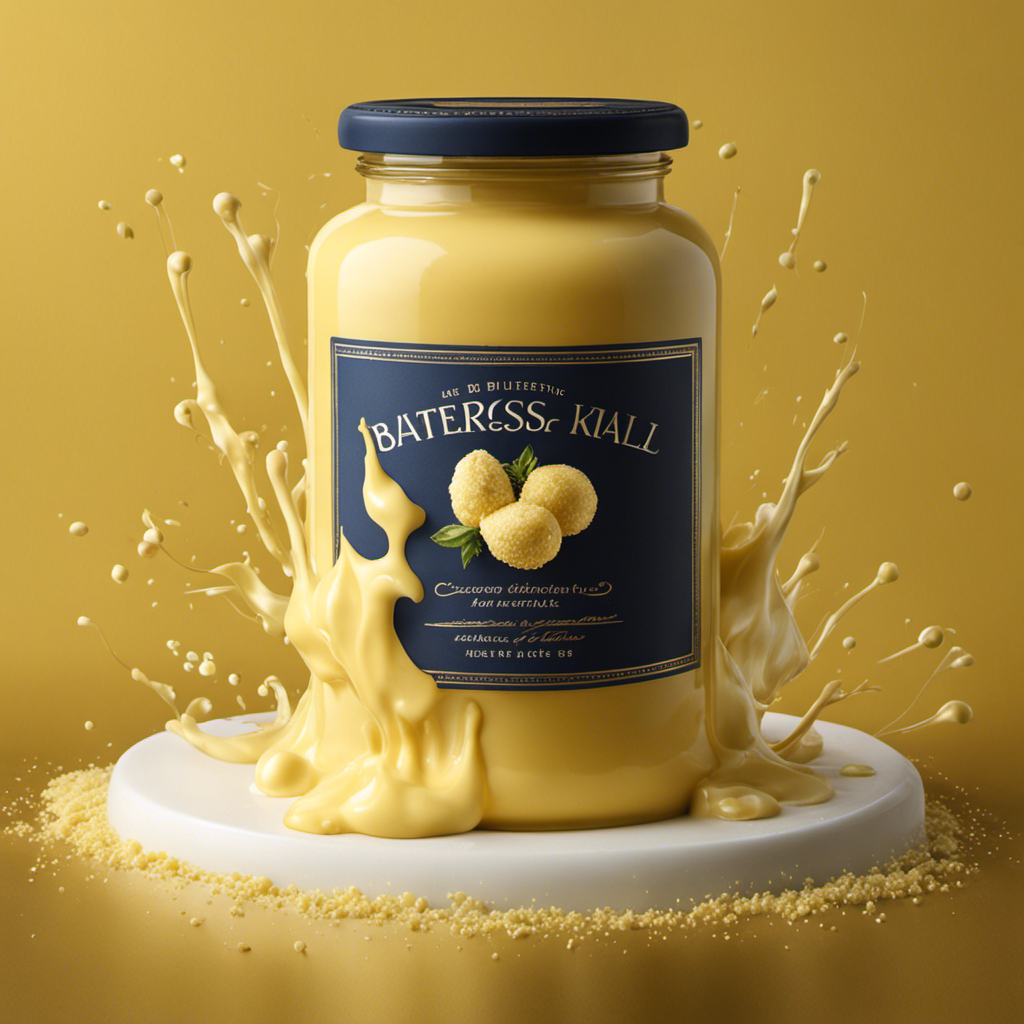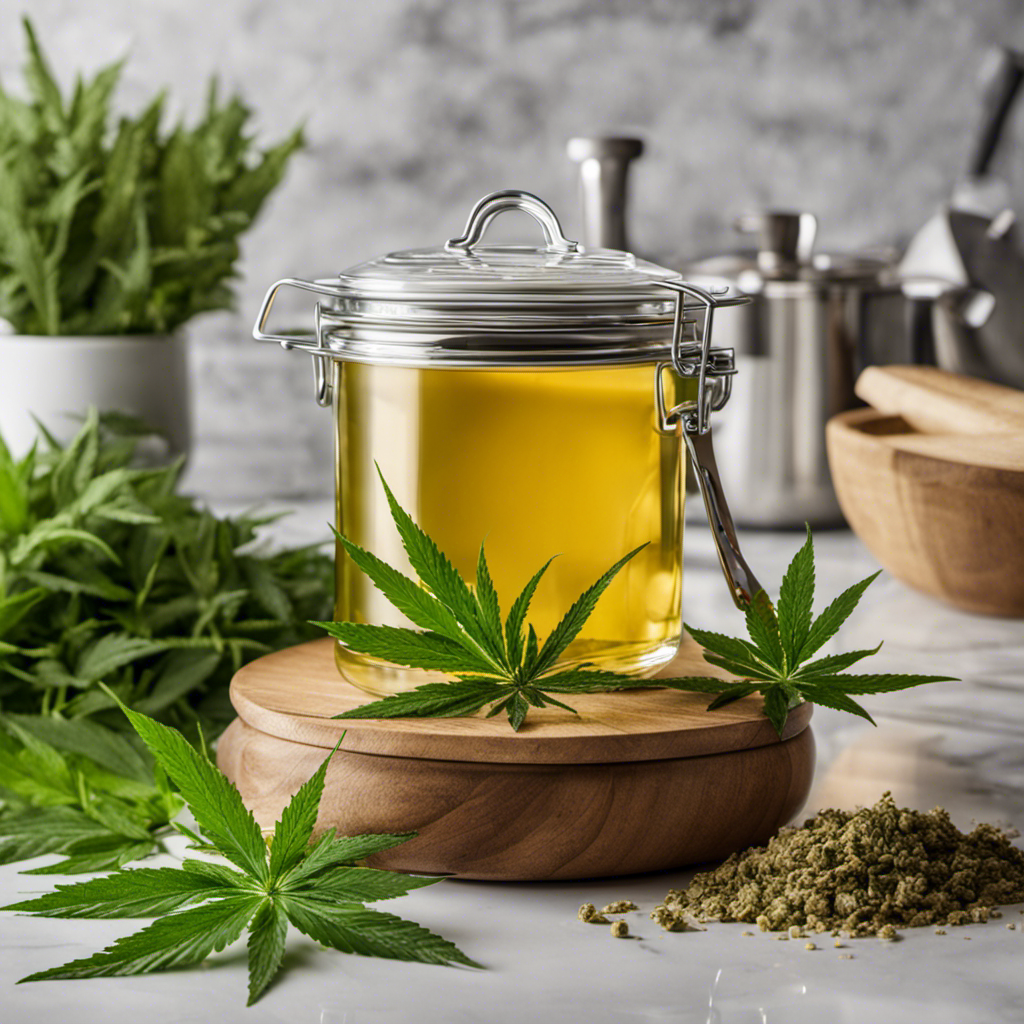As someone who enjoys delicious and indulgent flavors, I have found a secret ingredient that takes any dish to a whole new level of tastiness.
Introducing miso butter – a heavenly fusion of rich umami flavors and creamy buttery goodness.
In this article, I will guide you through the simple steps of creating your own mouthwatering batch of miso butter.
Get ready to embark on a culinary adventure that will revolutionize your cooking and tantalize your taste buds like never before.
Key Takeaways
- Miso butter can be made using soy sauce, butter, and miso paste as the main ingredients.
- The choice of miso brand and type (white, red, or mixed) will affect the saltiness and flavor profile of the miso butter.
- Miso butter can be used in both savory and sweet dishes, enhancing the flavors of roasted vegetables, grilled meats, cookies, cakes, and ice cream.
- Experimenting with different variations of miso butter, such as sweet, spicy, or herb-infused, can create a range of unique and delicious flavor combinations.
Ingredients for Miso Butter
To make miso butter, you’ll need soy sauce, butter, and miso paste. Miso butter is a versatile condiment that adds a rich umami flavor to any dish.
When choosing miso brands for this recipe, it’s important to consider the level of saltiness and the depth of flavor you prefer. Some popular options include white miso, red miso, and mixed miso.
White miso has a milder and sweeter taste, while red miso is more robust and salty. Mixed miso combines the best of both worlds, offering a balanced flavor profile. Experiment with different miso brands to find the one that suits your taste buds.
Now that we have our ingredients, let’s move on to the next step: choosing the right miso.
Choosing the Right Miso
When it comes to miso, there is a wide range of flavor profiles to explore. From the earthy and savory white miso to the rich and robust red miso, each type offers a unique taste experience.
In this discussion, we will delve into the different miso flavor profiles and provide some exciting pairing suggestions to enhance your culinary adventures. So, prepare your taste buds for a journey through the world of miso and get ready to discover new and delicious combinations that will elevate your dishes to the next level.
Miso Flavor Profiles
Discover the unique flavor profiles of different types of miso and how they can add depth and richness to your homemade miso butter.
Miso, a traditional Japanese ingredient, is made by fermenting soybeans with salt and koji (a type of mold). The resulting paste can vary in flavor, ranging from sweet and mild to bold and savory.
When combined with butter, miso creates a delicious umami-packed spread that can elevate any dish. White miso has a delicate, slightly sweet flavor, while red miso has a stronger, more robust taste.
Mixing different types of miso can create a complex flavor profile, combining the sweetness of white miso with the depth of red miso. Experimenting with miso flavor combinations allows you to tailor your miso butter to suit your taste preferences and enhance your culinary creations.
Miso Pairing Suggestions
Try experimenting with different dishes to find the perfect pairing for your homemade miso spread. Miso butter is a versatile ingredient that can elevate both savory and sweet dishes.
While it’s commonly used in savory recipes like roasted vegetables or grilled meats, don’t overlook its potential in desserts. Miso butter can add a unique and complex flavor to sweet treats like cookies, cakes, and even ice cream. The salty-sweet combination creates a delightful balance that will surprise your taste buds.
For a simple miso butter cookie recipe, mix together softened butter, sugar, flour, and a spoonful of miso butter. Bake until golden brown and enjoy the rich and savory flavor in every bite.
Step-by-Step Instructions for Making Miso Butter
To start making miso butter, you’ll first need to gather all of the necessary ingredients. When it comes to choosing miso brands, there are several options to consider. Look for a miso paste that suits your taste preferences, whether it’s white miso for a milder flavor or red miso for a stronger and saltier taste.
As for the health benefits of miso butter, it’s a great source of probiotics, which can improve digestion and boost your immune system. Miso is also rich in essential minerals like calcium, iron, and magnesium.
Once you have your miso paste, simply combine it with softened butter and mix until well incorporated. The result is a delicious and versatile spread that can be used in various dishes.
Now let’s move on to some tips for achieving the perfect texture.
Tips for Achieving the Perfect Texture
When mixing the miso paste with softened butter, be sure to thoroughly incorporate the two ingredients to achieve the perfect texture. This is crucial for achieving a smooth consistency that will spread effortlessly on your favorite dishes.
To help you visualize the process, imagine the rich, creamy butter blending seamlessly with the umami-packed miso paste, creating a velvety mixture that is both savory and indulgent.
The miso butter can be used in a variety of dishes, adding depth and complexity to everything from roasted vegetables to grilled meats. Its versatility knows no bounds, making it a must-have condiment in any kitchen.
Now that we’ve covered how to achieve the perfect texture, let’s explore the exciting world of flavor variations for miso butter.
Flavor Variations for Miso Butter
When it comes to flavor variations for miso butter, there are endless possibilities to explore.
One delicious option is sweet miso butter, which adds a touch of sweetness to balance out the umami flavors.
For those who prefer a little heat, spicy miso butter is the way to go, adding a fiery kick to any dish.
And if you’re looking to infuse your miso butter with fresh herbs, herb-infused miso butter is the perfect choice, offering a burst of aromatic flavors.
Get ready to elevate your dishes with these mouthwatering miso butter variations.
Sweet Miso Butter
For sweet miso butter, you’ll want to combine miso paste, unsalted butter, and honey in a bowl. This delicious concoction is perfect for adding a touch of sweetness to your dishes. Here’s how to make it:
- Start by scooping a generous amount of miso paste into the bowl.
- Next, add softened unsalted butter, allowing it to mix well with the miso paste.
- Finally, drizzle in some honey and stir until everything is thoroughly combined.
The result is a smooth and velvety sweet miso butter that can be used in a variety of ways. Spread it on warm toast for a delightful breakfast treat or use it as a glaze for roasted vegetables. You can even incorporate it into your favorite desserts, like miso butter cookies or miso butter frosting for cakes. The possibilities are endless!
Now that we’ve covered sweet miso butter, let’s move on to the next variation: spicy miso butter.
Spicy Miso Butter
To add a kick to your dishes, try mixing miso paste, unsalted butter, and chili flakes together for a spicy miso butter. This flavorful concoction is perfect for those who enjoy a little heat in their meals.
Spicy miso recipes are becoming increasingly popular due to the unique combination of spices and umami flavors. Not only does spicy miso butter enhance the taste of your dishes, but it also provides several health benefits.
Miso paste is packed with probiotics, which promote a healthy gut and boost the immune system. Additionally, chili flakes contain capsaicin, a compound known for its anti-inflammatory properties. By incorporating spicy miso butter into your meals, you are not only adding a burst of flavor but also nourishing your body.
Speaking of flavor, have you ever tried herb-infused miso butter?
Herb-Infused Miso Butter?
Have you ever tried infusing herbs into your spicy miso butter? It’s a simple and delicious way to elevate the flavors and create a unique twist on this versatile condiment.
By adding a handful of freshly chopped herbs to your miso butter, you’ll not only enhance the umami richness of the miso, but also add a fresh and vibrant herbal note.
Here are three herb-infused miso butter recipe variations to try:
-
Rosemary Infused: The earthy and fragrant aroma of rosemary pairs beautifully with the savory miso, creating a perfect balance of flavors.
-
Basil Infused: The sweet and slightly peppery notes of basil add a refreshing touch to the rich miso butter, making it perfect for spreading on crusty bread or tossing with pasta.
-
Cilantro Infused: For those who love the bright and citrusy flavors of cilantro, infusing it into miso butter adds a zesty kick, perfect for grilled meats or roasted vegetables.
Give these herb-infused miso butter recipes a try and discover a whole new world of flavor possibilities!
Storing and Preserving Miso Butter
You should store and preserve your miso butter in an airtight container in the refrigerator to maintain its freshness and flavor. Miso butter is a versatile condiment that adds a rich umami flavor to various dishes. To extend its shelf life, proper storage is crucial. When stored in an airtight container, miso butter can last for up to a month in the refrigerator. It’s important to keep it away from strong odors to prevent flavor contamination. Additionally, freezing miso butter is a great option if you want to preserve it for longer periods. Simply portion it into smaller containers or wrap it tightly in plastic wrap before freezing. When you’re ready to use it, just thaw it in the refrigerator overnight.
Here’s a table to help you understand how to store and preserve miso butter:
| Storage Method | Shelf Life |
|---|---|
| Refrigerator | Up to 1 month |
| Freezer | Up to 6 months |
Delicious Ways to Use Miso Butter
There are countless delicious recipes that incorporate the rich umami flavor of miso butter. Whether you’re a fan of savory or sweet dishes, miso butter can elevate any meal to new heights. Here are a few mouthwatering ideas to inspire your culinary adventures:
- Spread miso butter on warm crusty bread, allowing the flavors to meld together in a satisfying bite.
- Toss roasted vegetables with a dollop of miso butter for a savory and satisfying side dish.
- Use miso butter as a marinade for grilled meats or seafood, infusing them with a delicious umami kick.
Not only does miso butter add a burst of flavor to your dishes, but it also offers several health benefits. Miso, a fermented soybean paste, is rich in probiotics, which promote a healthy gut and boost your immune system. Additionally, miso contains essential minerals and vitamins, making it a nutritious addition to your diet.
Frequently Asked Questions
How Long Can I Store Miso Butter?
Miso butter can be stored for up to two weeks in the refrigerator. To maximize its shelf life, it’s important to store it in an airtight container. This is the best storage method to keep it fresh and flavorful.
Can I Use Any Type of Butter to Make Miso Butter?
Yes, you can use any type of butter to make miso butter. The different types of butter will add their own unique flavors to the miso butter, enhancing the taste of your recipes.
Can I Substitute Miso Paste With Any Other Ingredient?
When making miso butter, alternatives to miso paste are limited. Miso’s unique flavor and umami cannot be easily replaced. However, you can experiment with other fermented pastes like soybean or fish sauce to achieve a similar savory depth. Incorporate miso butter into various recipes like roasted vegetables or grilled seafood for added richness and complexity.
Can I Use Miso Butter for Cooking or Just as a Spread?
You can use miso butter for both cooking and as a spread. It adds a rich, savory flavor to dishes and works well as a marinade for meat. You can also experiment with different flavor variations of miso butter.
Can I Freeze Miso Butter for Long-Term Storage?
Yes, you can freeze miso butter for long-term storage. It’s a great way to preserve its flavor and extend its shelf life. Plus, you can experiment with different variations of miso butter to add more depth to your dishes.
Conclusion
In conclusion, making miso butter is the culinary equivalent of unlocking the gates to flavor paradise.
With just a few simple steps, you can create a creamy, umami-packed spread that will elevate any dish to new heights.
The combination of rich miso and velvety butter is a match made in gastronomic heaven.
Whether you spread it on toast, melt it over vegetables, or use it to baste meat, miso butter will take your taste buds on a flavor adventure they won’t soon forget.
So, what are you waiting for? Get ready to experience a buttery revelation like no other with homemade miso butter.









